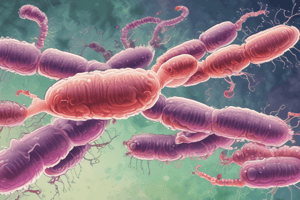Podcast
Questions and Answers
What is the primary characteristic of Pseudomonas aeruginosa in terms of oxygen requirement?
What is the primary characteristic of Pseudomonas aeruginosa in terms of oxygen requirement?
- Facultative anaerobe
- Obligate anaerobe
- Obligate aerobe (correct)
- Microaerophilic
Which of the following virulent factors is associated with Pseudomonas aeruginosa?
Which of the following virulent factors is associated with Pseudomonas aeruginosa?
- Exotoxin A (correct)
- Endotoxin B
- Capsule formation
- Coagulase
Which population is at higher risk of infections caused by Pseudomonas aeruginosa?
Which population is at higher risk of infections caused by Pseudomonas aeruginosa?
- Neutropenic patients (correct)
- Elderly without comorbidities
- Young adults
- Healthy children
What type of infections is commonly associated with Pseudomonas aeruginosa?
What type of infections is commonly associated with Pseudomonas aeruginosa?
How does Pseudomonas aeruginosa commonly resist antibiotic treatment?
How does Pseudomonas aeruginosa commonly resist antibiotic treatment?
Flashcards are hidden until you start studying
Study Notes
Pseudomonas aeruginosa
- A common pathogen in humans, particularly in hospital settings.
- Found in moist areas like sinks, drains, and respiratory equipment.
- Requires oxygen to survive (obligate aerobe).
- Produces a distinctive sweet grape-like odor.
- An oxidase-positive bacterium, meaning it can utilize oxygen in a specific way.
- Unable to ferment glucose or lactose.
- Grows at 42 degrees Celsius, a relatively high temperature for bacteria.
Gram-Negative Characteristics
- Belongs to the gram-negative bacteria category.
- Has a flagellum that allows it to move (motile).
- Prefers oxygen for growth (aerobic).
- Widely present in environments like water, plants, and animals.
Infections
- Can cause infections of the skin, eyes, and ears.
Serious Infections
- Can lead to severe and dangerous illnesses such as:
- Ventilated-associated pneumonia (VAP), a lung infection in people on ventilators.
- Nosocomial pneumonia, pneumonia acquired in a hospital setting.
- Urinary tract infections (UTIs).
At Risk Populations
- Certain individuals are more susceptible to Pseudomonas aeruginosa infections:
- People with low white blood cell counts (neutropenic patients).
- Burn patients.
- Cystic fibrosis (CF) patients.
- Patients on mechanical ventilators.
Virulent Factors
- Possesses factors that contribute to its virulence:
- Exotoxin A: A toxin that damages cells.
- Pili: Hair-like structures that help it attach to surfaces.
- Lipopolysaccharide: A component of its outer membrane that triggers inflammation.
- Ability to colonize and persist in the body for long periods.
Mechanism of Resistance
- It can resist antibiotics through various mechanisms:
- Beta-lactamase: An enzyme that breaks down certain antibiotics.
- Biofilm formation: A protective layer that shields it from antibiotics.
- Multi-drug efflux pumps: Systems that pump out antibiotics from its cells.
Studying That Suits You
Use AI to generate personalized quizzes and flashcards to suit your learning preferences.




